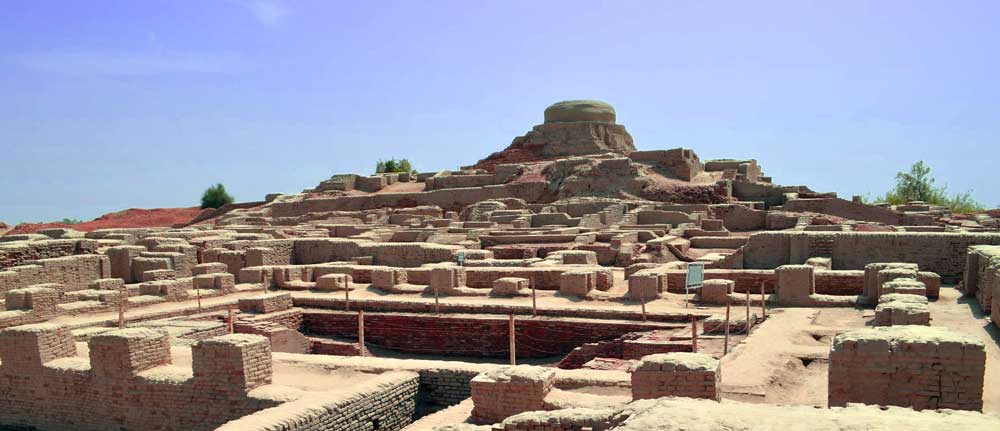 Mohenjo-Daro is one of the oldest cities of the Indus Valley Civilization, which thrived around 4,500 years ago. Located in Sindh, Pakistan, its name means “Mound of the Dead” in the Sindhi language. It stands out as an extraordinary ancient city because of its advanced urban planning, including its city layout, roads, houses, and drainage systems.
Mohenjo-Daro is one of the oldest cities of the Indus Valley Civilization, which thrived around 4,500 years ago. Located in Sindh, Pakistan, its name means “Mound of the Dead” in the Sindhi language. It stands out as an extraordinary ancient city because of its advanced urban planning, including its city layout, roads, houses, and drainage systems.
The remarkable design of the city indicates that it probably remained a hub of culture, trade, and technology. It featured proper marketplaces, storage facilities, and even public baths, which show that these people valued commerce and community life.
Discovery of Mohenjo-Daro
Mohenjo-Daro was discovered during an archaeological excavation led by Sir John Marshal in the 1920s. He uncovered the site near the Indus River, which is in present-day Sindh, Pakistan. His discovery marked a groundbreaking milestone in archaeology for revealing an advanced urban civilization that is 4,500 years old.
Sir John Marshal was the Director-General of the Archeological Survey of India during that time. He began excavation systematically and soon realized the significance of the Site. His discovery also recognized the Indus Valley civilization globally as one of the earliest urban cultures in human history.
The City’s Layout and Features
 Mohenjo-Daro was not a randomly designed city. Instead, it was a carefully planned city having straight and wide streets made in a grid pattern. One of the most advanced features is its advanced drainage system, to which every house is connected. The drainage system covered and carried wastewater away. The houses in the city were well-made with bricks, and their design included multiple rooms and a courtyard. Further, there were separate structures for marketplaces and the storage of grains.
Mohenjo-Daro was not a randomly designed city. Instead, it was a carefully planned city having straight and wide streets made in a grid pattern. One of the most advanced features is its advanced drainage system, to which every house is connected. The drainage system covered and carried wastewater away. The houses in the city were well-made with bricks, and their design included multiple rooms and a courtyard. Further, there were separate structures for marketplaces and the storage of grains.
The Great Bath

The city’s center had one of the famous structures known as the Great Bath. It is a large rectangular water pool made with backed bricks and waterproofed from leakage with a special material. The Great Bath was laid with steps on both sides for entering the pool. Also, it had a dedicated system of drainage for water flushing. The Great Bath was planned so carefully that archeologists believe that it may have been used for religious rituals.
Life in Mohenjo-Daro
The people of Mohenjo-Daro were very productive and well-organized. They were experts in farming, trading, crafting, and building. They grew various types of crops, including wheat, barley, and peas, using stone and metal tools made with Copper and bronze. They used the water of the Indus River to irrigate their crops.
Trade has also remained an important part of their daily lives. They traded various goods within the region. Archeologists have also found evidence that they traded with faraway lands, including Mesopotamia.
The social structuring of people is still a mystery, but archeologists suggest that the community appears to have lived in harmony and had shared public spaces like baths, granaries, and water wells.
Decline and Mystery
Mohenjo-Daro’s decline has remained one of the great mysteries in archeology. Archaeological evidence suggests that the city’s decline happened around 1,900 BCE. The population of people was declining, and the exact cause is yet to be discovered.
Various theories shed Light on the possible abandonment of the city. Here are some of the famous theories:
- Environmental Change: Some experts suggest that, Indus River may have changed its course and caused flooding in the region, which made farming and daily life difficult. Or perhaps a drought could have hit the region and caused water scarcity.
- Conflicts or Invasions: This theory suggests that there could have been a regional war that destroyed the civilization. Or invaders of the northwest could have attacked the region. However, there is no strong evidence that supports this theory.
- Natural Disaster: This theory supports the idea of Earthquakes that could have struck the region and caused destruction.
Fun Facts
- No grand palace or temples have been discovered in Mohenjo-Daro.
- Many written tablets of the Mohenjo-Daro people have been found, but they are yet to be decoded.
- Mohenjo-Daro was declared a UNESCO World Heritage Site in 1980 to help preserve the ancient city.





